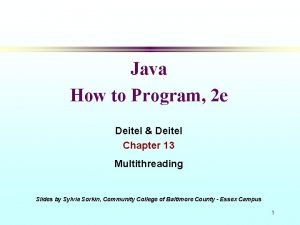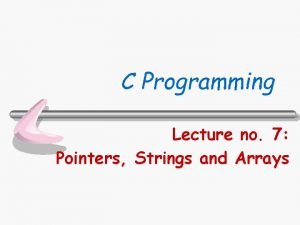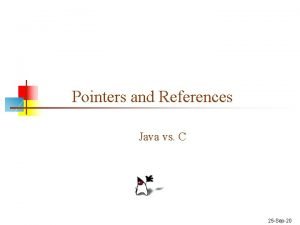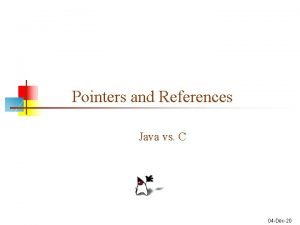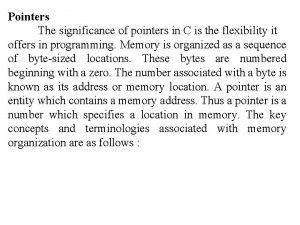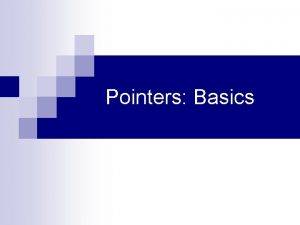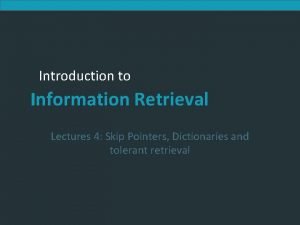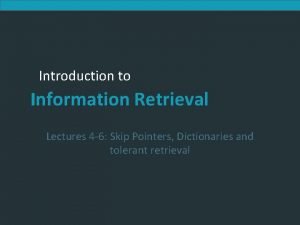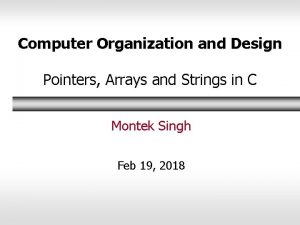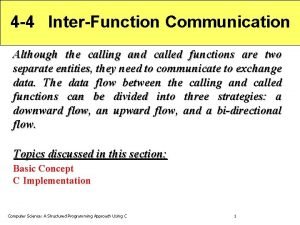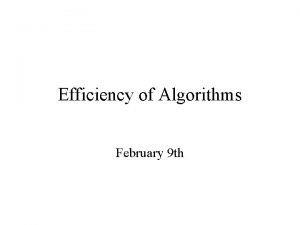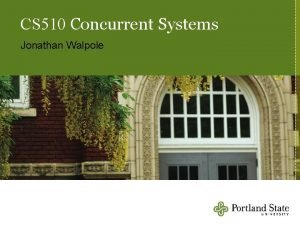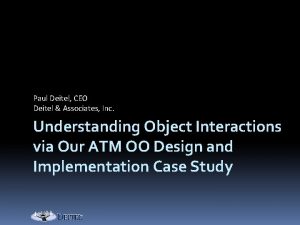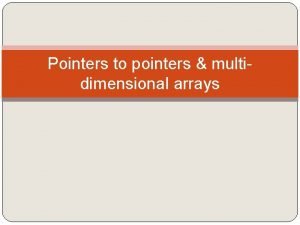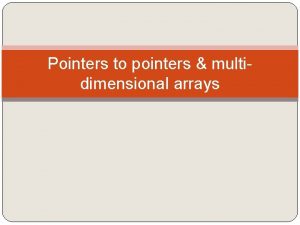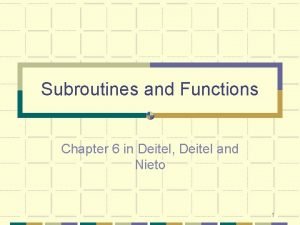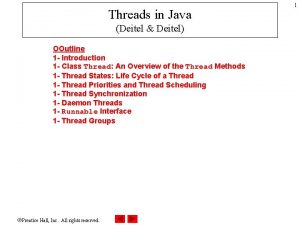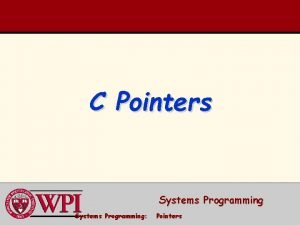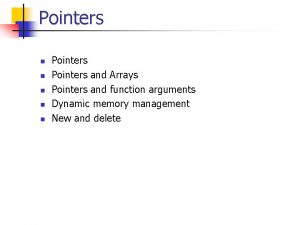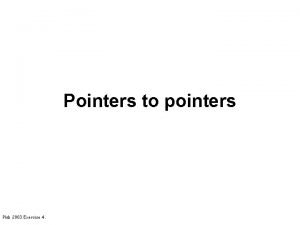Chapter 8 Pointers Paul J Deitel and Harvey






![8. 8 Pointer Arithmetic (P. 381) • int v[5]; • int* v. Ptr = 8. 8 Pointer Arithmetic (P. 381) • int v[5]; • int* v. Ptr =](https://slidetodoc.com/presentation_image_h2/dd85ebdde0c5e5a4435d8a939e64ed20/image-7.jpg)









- Slides: 16

Chapter 8 Pointers Paul J. Deitel and Harvey M. Deitel, C++ How to Program, 8 th Edition, Pearson Education. 1

Address-of Operator (&) (P. 364) Dereference Operator (*) int y = 5; int* y. Ptr = &y; location 500000 y. Ptr location 600000 y 600000 *y. Ptr = *y. Ptr + 1; // *&y = *&y + 1; // y = y + 1; Q: What will the following code display? int c = 'A'; int* pc = &c; cout << *pc; 5 2

Pass-by-Value vs. Pass Pointers to a Function void inc(int n) { n += 10; cout << n << endl; } void inc(int* n) { *n += 10; cout << *n << endl; } int main() { int n = 10; inc(n); cout << n << endl; return 0; } int main() { int n = 10; inc(&n); cout << n << endl; return 0; } 20 10 20 20 3

8. 5 Using const with Pointers (P. 371) #include <iostream> void show(char* s) { std: : cout << std: : endl; } int main() { show("Good morning. "); return 0; } Warning: conversion from string literal to 'char *' is deprecated 4

Four ways to pass a pointer to a function (P. 372) • Non-constant Pointer to Non-constant Data • int* p. Number • Non-constant Pointer to Constant Data • const int* size. Ptr • Constant Pointer to Non-Constant Data • int* const p. Array • Constant Pointer to Constant Data • const int* const p. Read. Only. Array 5

8. 7 sizeof Operator (P. 379) • The sizeof operator returns the total number of bytes. • The returned value is of type size_t (unsigned int). • You may apply sizeof to a variable or a data type. • int a[10]; • class Point { public: int x; int y; }; • Point p 1; sizeof a[0] sizeof a / sizeof a[0] sizeof(int) sizeof(p 1) sizeof(Point) // // // 40 4 10 4 8 8 Parenthesis is required when the operand is a data type 7
![8 8 Pointer Arithmetic P 381 int v5 int v Ptr 8. 8 Pointer Arithmetic (P. 381) • int v[5]; • int* v. Ptr =](https://slidetodoc.com/presentation_image_h2/dd85ebdde0c5e5a4435d8a939e64ed20/image-7.jpg)
8. 8 Pointer Arithmetic (P. 381) • int v[5]; • int* v. Ptr = v; • int* v. Ptr = &v[0]; • v. Ptr += 2; • cout << v. Ptr; • ++v. Ptr; • cout << (v. Ptr - v); The address is not simply incremented by 2, but size(int)*2. 8

reinterpret_cast (P. 383) • int* and char* are different data types. • Although both are a memory address • int* points to an integer (4 bytes) • char* points to a character (1 byte) • when dereferenced, these two pointers retrieve different data. • Consider the code • char c = 65; int* pc = &c; • Error: cannot convert ‘char*’ to ‘int*’ • int* pc = reinterpret_cast<int*>(&c); 9

pointer to void (void*) • void* is a generic pointer capable of representing any pointer type. • All pointer types can be assigned to a pointer of type void* without casting. • However, a pointer of type void* cannot be assigned directly to a pointer of another type. It must be cast. • • char a[4] = { 'A' }; void* pa = a; int* p = static_cast<int*>(pa); // (int*) pa cout << reinterpret_cast<int*>( a ); 10


How to Store a 4 -Byte Integers in Memory • 16909060 10 = 0 x 01020304 (0102030416) • How will it be stored in memory? Big-Endian 0 x. A 000 01 0 x. A 001 02 0 x. A 003 03 04 01 02 03 04 Little-Endian 0 x. A 000 0 x. A 001 0 x. A 002 04 03 02 0 x. A 003 01 12

Exercise: Big-Endian vs. Little Endian • Big Endian • IBM S/390, Motorola 68 k, Sun SPARC, • “Big Endian is Effectively Dead” • Little Endian • Intel x 86 • Bi-Endian • Power. PC, ARM On your host, can you write a program to inspect whether it stores integers in big-endian or little-endian? integer 16909060 is stored at Using pointer. . . 0093 FAB 8 4 0093 FAB 9 3 0093 FABA 2 0093 FABB 1 Using union. . . 0093 FA 7 C 0093 FA 7 D 0093 FA 7 E 0093 FA 7 F 4 3 2 1 13

8. 9 Relationship Between Pointers and Arrays (P. 384) • An array name can be thought of as a constant pointer. • int b[ 5 ]; • int *b. Ptr; • b. Ptr = b; • b. Ptr = &b[ 0 ]; • • b[3] // array subscript notation *(b. Ptr + 3) // pointer/offset notation *(b + 3) // array name is a pointer b. Ptr[3] // pointer can be used as an array name 14

8. 12 Function Pointers (P. 390) • When you encounter the terminology “callback function” in the future, come back to study this concept again. • Passing a “pointer to function” into a function makes your program flexible. int add(int a, int b) { return a + b; } int multiply(int a, int b) { return a * b; } int main() The parenthesis cannot be omitted. { int (*f)(int, int); f = add; cout << f(12, 3) << endl; f = multiply; cout << f(12, 3) << endl; } 15

int add(int a, int b) { return a + b; } An Array of Function Pointers int sub(int a, int b) { return a - b; } int multiply(int a, int b) { return a * b; } int divide(int a, int b) { return a / b; } int main() { int (*f[4])(int, int) = { add, sub, multiply, divide }; for (int i=0; i<4; ++i) cout << f[i](12, 3) << endl; return 0; } 16

void show( int a, int b, int (*f)(int, int) ) { cout << f(a, b) << endl; } Callback Function int add(int a, int b) { return a + b; } int sub(int a, int b) { return a - b; } int multiply(int a, int b) { return a * b; } int divide(int a, int b) { return a / b; } int main() { int (*f[4])(int, int) = { add, sub, multiply, divide }; for (int i=0; i<4; ++i) show(12, 3, f[i]); return 0; } 17
 Deitel and deitel
Deitel and deitel Pointers and strings
Pointers and strings & vs * in c
& vs * in c & vs * in c
& vs * in c Advantages of pointers
Advantages of pointers Importance of pointer
Importance of pointer C array of pointers to structs
C array of pointers to structs Pointers basics
Pointers basics Skip pointers in information retrieval
Skip pointers in information retrieval Skip pointer
Skip pointer Which is a good idea for using skip pointers
Which is a good idea for using skip pointers Explicit pointer
Explicit pointer Java pointer to array
Java pointer to array Inter function communication in c
Inter function communication in c Swizzling glsl
Swizzling glsl Converging pointers algorithm
Converging pointers algorithm Hazard pointers
Hazard pointers
